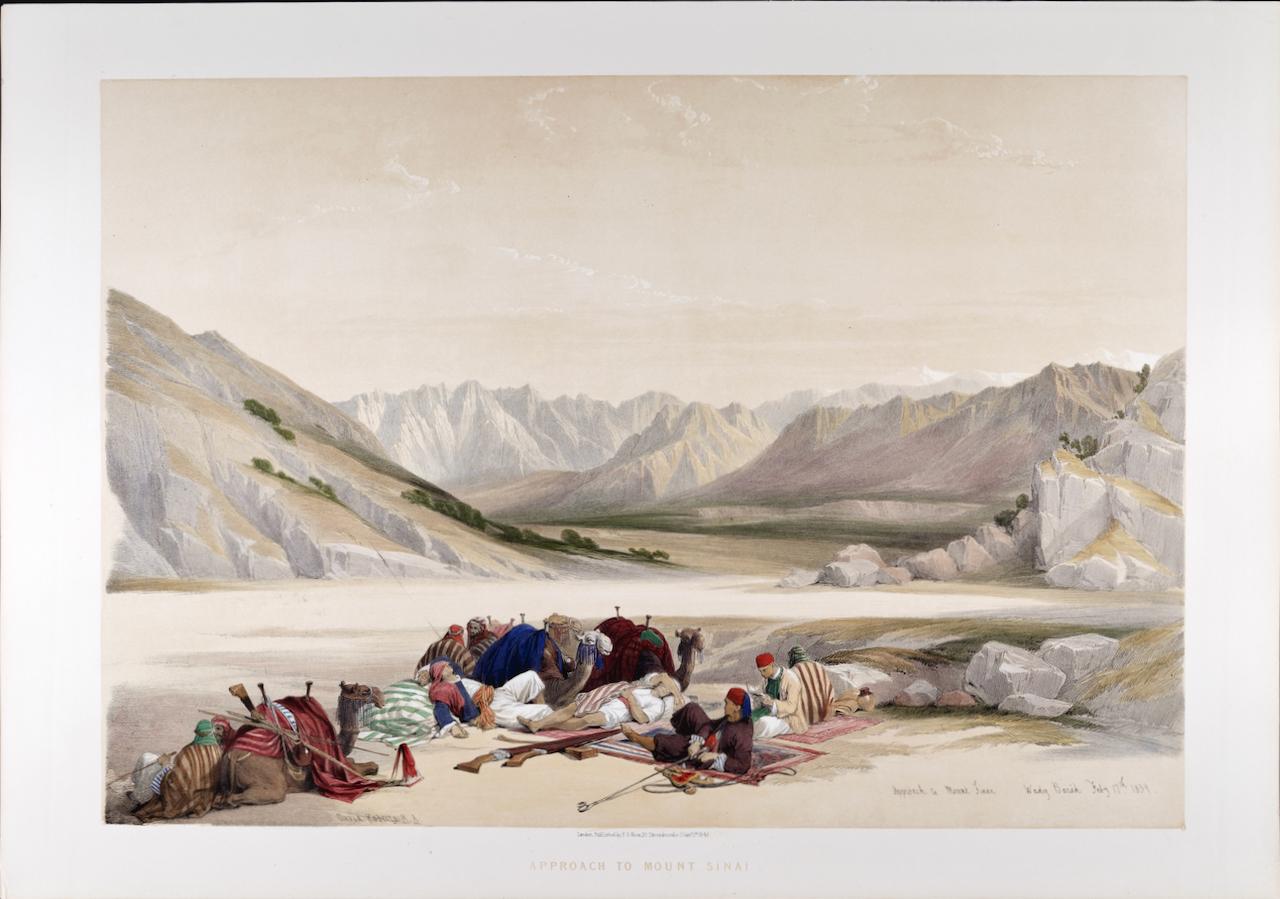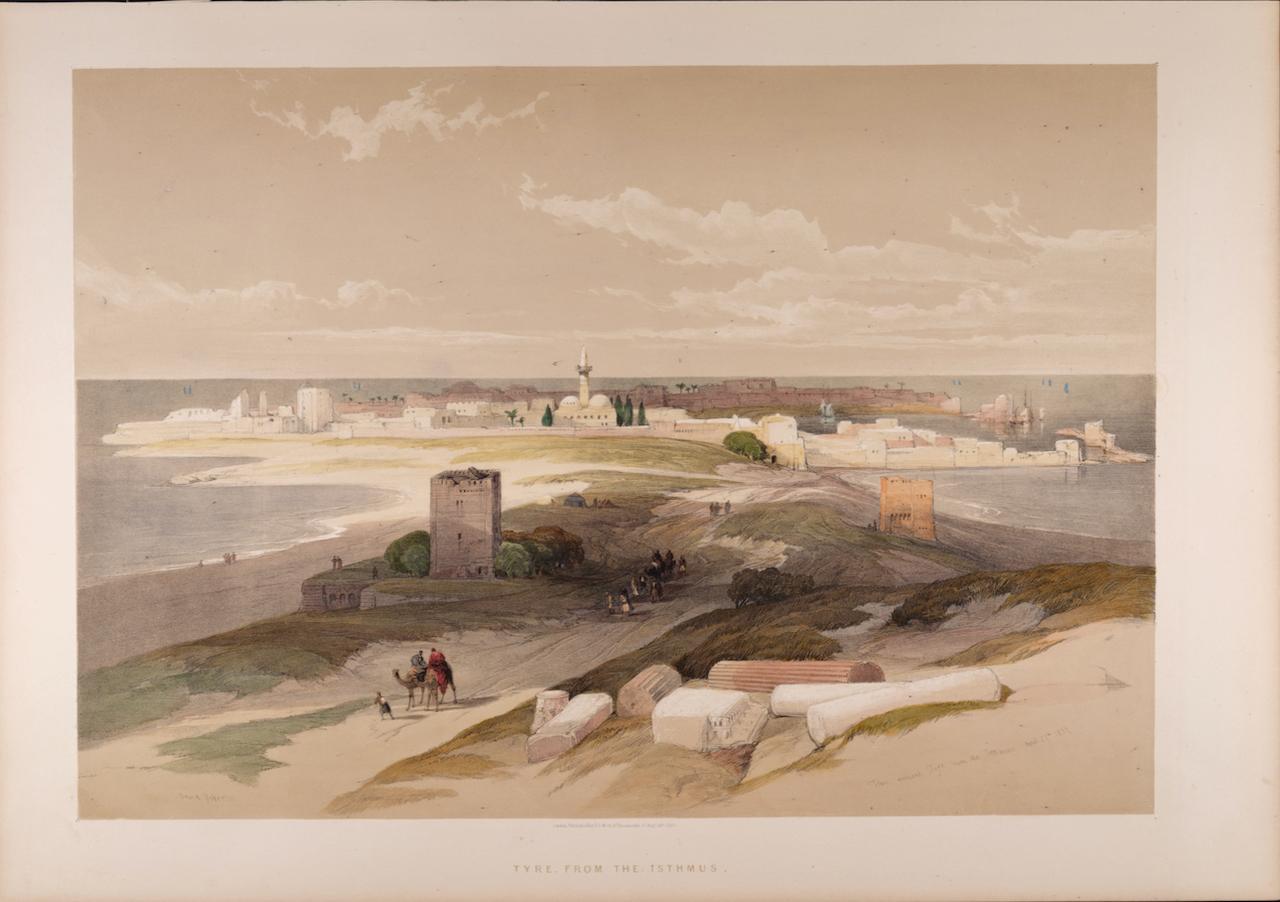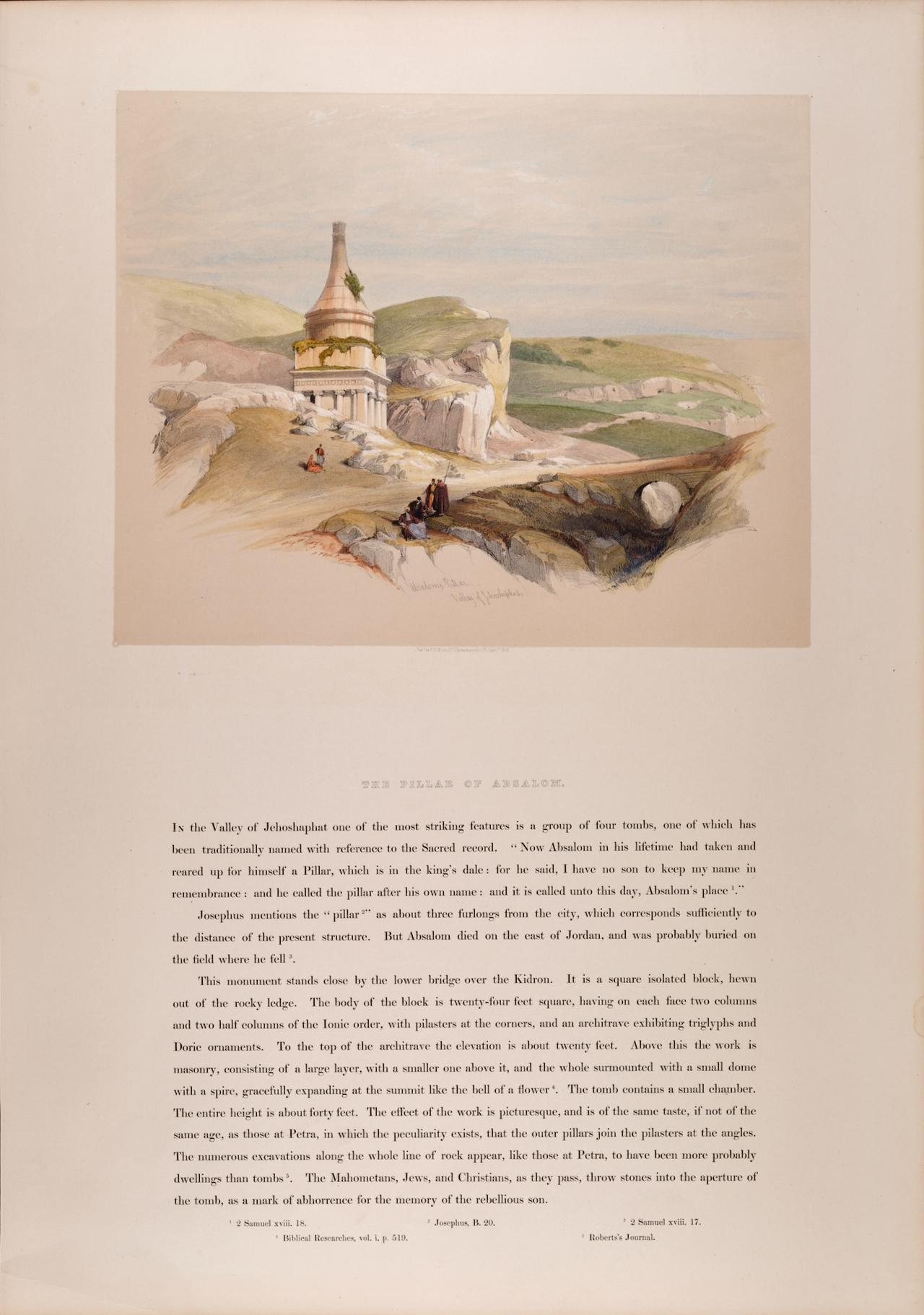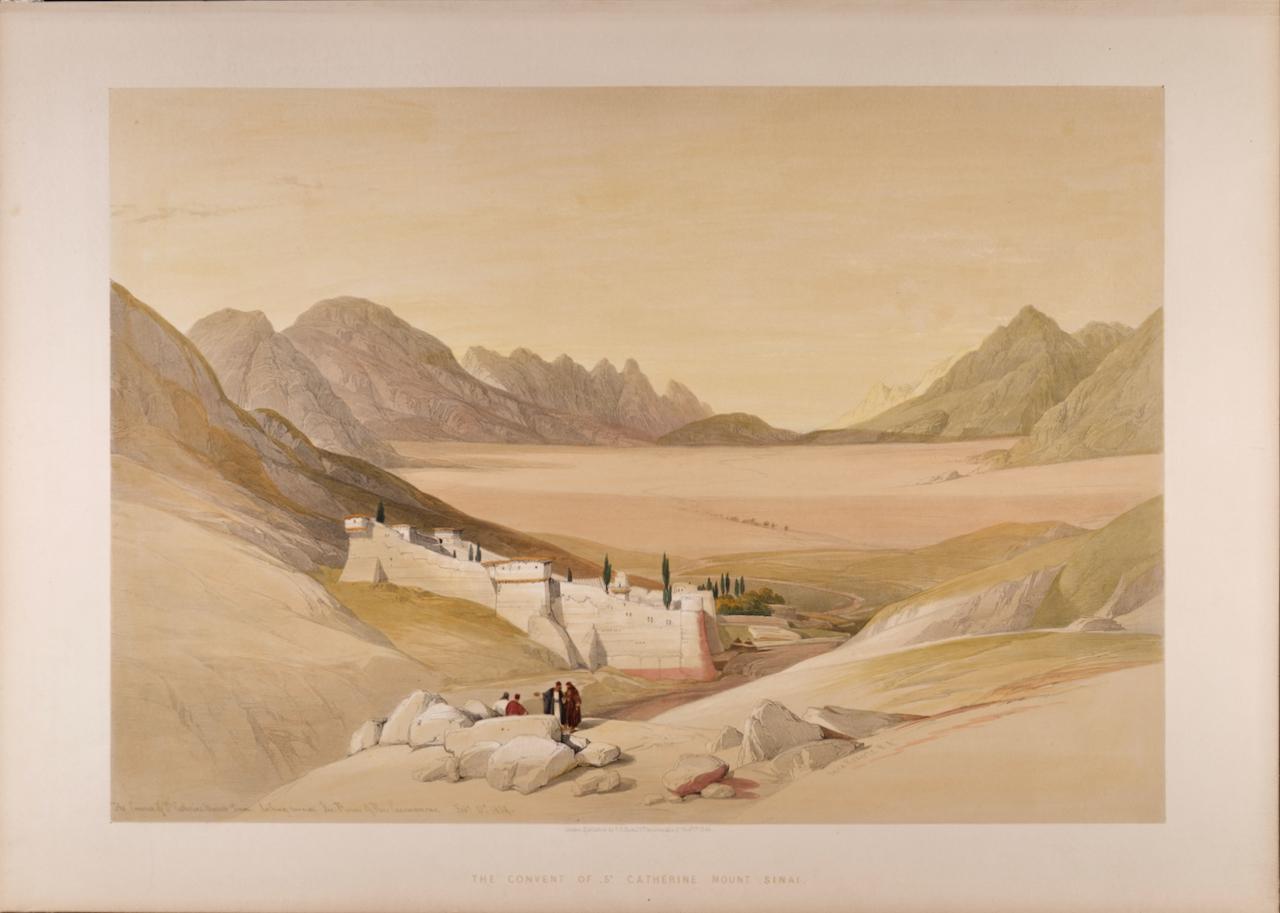Items Similar to Tiberias from the Walls: David Roberts' 19th C. Hand-colored Lithograph
Want more images or videos?
Request additional images or videos from the seller
1 of 8
David RobertsTiberias from the Walls: David Roberts' 19th C. Hand-colored Lithograph1842
1842
About the Item
This is an original 19th century hand-colored lithograph entitled "Tiberias from the Walls, Saffet (Safed) in the Distance" by David Roberts, from his Egypt and Nubia volumes of the large folio edition, published in London by F. G. Moon in 1841. The lithographs were prepared by Louis Haghe (1806-1885) from drawings and paintings by Roberts. The resultant large folio editions of 'The Holy Land' and 'Egypt & Nubia' are considered among the greatest lithographically illustrated works issued in the 19th century.
This page from Roberts' 19th century publication includes a half-folio hand-colored lithograph of a view of the town of Tiberias and with the town of Safed on the hill in the distance. They lie along the Sea of Galilee and near the Jordan River. Tiberias and Safed are two of the four holy cities of Judea; the others being Jerusalem and Hebron. Local men in their traditional costumes are seen on the walls of Tiberias. Men and women are seen along the shore of the Sea of Galilee, alongside a small boat. Two women carry vessels on their head, possibly containing water.
The print is signed, titled and dated in plate in Roberts' own hand written script, as it appeared in the sketch in his journal. The date, April 22, 1839 is the day Roberts visited the area. The lower portion of the page contains text from Roberts' journal. This print can be displayed in its entirety, including both the lithograph and the text. Another option is to frame only the lithographic image. The text could be displayed on the back of the frame, perhaps glazed.
This hand-colored lithograph print is printed on wove paper with wide margins. The sheet measures 23.88" high and 16.88" wide. The print is in excellent condition.
Tiberias is an Israeli city on the western shore of the Sea of Galilee, dating from around 18 CE. It was founded by Herod Antipas, tetrarch (ruler of a quarter) of Galilee under the Romans. He was the son of Herod the Great, King of Judea. It was named for the reigning Roman emperor Tiberius. From the second through the tenth centuries CE, Tiberias was the largest Jewish city in the Galilee, and a political and religious hub of the Jews in the Land of Israel. After the destruction of the Temple in Jerusalem by the Romans, Galilee became the chief Jewish centre of Palestine, and Tiberias, its principal city, grew in importance.
Safed has been identified with Sepph, a fortified town in the Upper Galilee mentioned in the writings of the Roman-Jewish historian Josephus. It is near Magdala, the ancient fishing town where Mary Magdalene was born. Safed was the site of battles during the crusades. Some believe that Safed was the " City set on a Hill," mentioned in the Sermon on the Mount, and that the Hill itself was the Mount of the Transfiguration, but this belief is controversial. Safed was heavily fortified in ancient times because of religious importance. This area is very susceptible to earthquakes. A powerful earthquake devastated the area only a year before Roberts' visit, with major loss of life.
David Roberts (1796-1864) was a Scottish artist, born outside of Edinburgh, Scotland. At age 10 he became a house painter’s apprentice. He continued painting houses and eventually theater scenes in Edinburgh and then in London. His friend, J. M. W. Turner, recognized his artistic talent and encouraged him to become a full-time artist.
In 1839 Roberts traveled to Egypt and then in 1840, through the Holy Land, concluding in Jerusalem. Upon his return to England, F. G. Moon agreed to publish lithographs created by Louis Haghe from Robert’s sketches and watercolors. This publication was highly acclaimed and very popular for its esthetic quality, its historical and topographical accuracy, as well as Roberts' dramatic depiction of his scenes. His views often included people in their native attire, which provided a dramatic perspective of the size of the architecture. Queen Victoria and Charles Dickens were among the subscribers who collected his works. Roberts' and Haghe’s duotone lithographs, often colored, remain extremely sought-after today and have been rising steadily in value. This work, and his large oil paintings of similar subjects, made him a prominent Orientalist painter. He also produced paintings and lithographs based on his travels in Great Britain and Europe. He was elected as a Royal Academy in 1841. The firm of Day & Haghe produced the lithographs for Roberts' publications. It was one of the most prominent lithographic companies of the nineteenth-century and were pioneers in the evolution of chromolithography.
- Creator:David Roberts (1796-1864, British)
- Creation Year:1842
- Dimensions:Height: 23.88 in (60.66 cm)Width: 16.88 in (42.88 cm)
- Medium:
- Movement & Style:
- Period:
- Framing:Framing Options Available
- Condition:
- Gallery Location:Alamo, CA
- Reference Number:
About the Seller
5.0
Platinum Seller
These expertly vetted sellers are 1stDibs' most experienced sellers and are rated highest by our customers.
Established in 2011
1stDibs seller since 2019
233 sales on 1stDibs
Typical response time: 1 hour
- ShippingRetrieving quote...Ships From: Alamo, CA
- Return PolicyA return for this item may be initiated within 7 days of delivery.
More From This SellerView All
- Approach to Mount Sinai 1839: Roberts' 19th C. Hand-colored LithographBy David RobertsLocated in Alamo, CAThis is an original 19th century hand-colored lithograph entitled "Approach to Mount Sinai Wady Barah Feby 17th 1839" by David Roberts, Plate 122 in Volume III of his Egypt and Nubia...Category
1840s Realist Interior Prints
MaterialsLithograph
- Temple of Kalabshi, Egypt: David Roberts' 19th C. Hand-colored LithographBy David RobertsLocated in Alamo, CAThis is an original 19th century hand-colored lithograph entitled "Portico of the Temple of Kalabshi" by David Roberts, from his Egypt and Nubia volumes of the large folio edition, p...Category
1840s Realist Interior Prints
MaterialsLithograph
- Tyre, From the Isthmus: Roberts' 19th C. Hand-colored LithographBy David RobertsLocated in Alamo, CAThis is an original 19th century hand-colored lithograph entitled "Tsur Ancient Tyre, From the Isthmus, April 27, 1839" by David Roberts from his Egypt and Nubia volumes of the large...Category
1840s Realist Interior Prints
MaterialsLithograph
- Church of St. Helena, Bethleham: Roberts' 19th C. Hand-colored LithographBy David RobertsLocated in Alamo, CAThis is an original 19th century hand-colored lithograph entitled "Church of St. Helena, Bethlehem" by David Roberts, plate 43 in volume II from his Egypt and Nubia volumes of the large folio edition, published in London by F. G. Moon in 1842. The lithographs were prepared by Louis Haghe (1806-1885) from drawings and paintings by Roberts. The resultant large folio editions of 'The Holy Land' and 'Egypt & Nubia' are considered the greatest lithographically illustrated works issued in the 19th century. The print depicts a view of the interior of the Church of St. Helena (also known as the Church of the Nativity), near the altar. The church is located in Bethlehem, in the West Bank of Palestine. Roberts visited the site between April 4-6, 1839. Men, women and children dressed in colorful traditional local garb are involved in various activities, some praying at the shrine, as part of a religious service, others talking in small groups or resting on the steps. The church was originally commissioned in 327 by Constantine the Great and his mother Helena over the site that was traditionally considered to be located over the cave that marks the birthplace of Jesus. Constantine was the first Roman emperor to convert to Christianity. He made Christianity the official religion of Rome. He founded Constantinople, which became the most powerful city in the world. The Church of the Nativity site's original basilica was completed in 339, but it was destroyed by fire during the Samaritan Revolts in the 6th century. A new basilica was built 565 by the Byzantine Emperor Justinian...Category
1840s Realist Interior Prints
MaterialsLithograph
- Pillar of Absalom near Jerusalem: David Roberts' 19th C. Hand-colored LithographBy David RobertsLocated in Alamo, CAThis is an original 19th century hand-colored lithograph entitled "Absaloms Pillar, Valley of Schoshaphat" by David Roberts, from his Egypt and Nubia volumes of the large folio editi...Category
1840s Realist Interior Prints
MaterialsLithograph
- Convent of St. Catherine, Mount Sinai: Roberts' 19th C. Hand-colored LithographBy David RobertsLocated in Alamo, CAThis is an original 19th century hand-colored lithograph entitled "Convent of St. Catherine Mount Sinai Looking Towards the Plain of the Encampment" by David Roberts, from his Egypt ...Category
1840s Realist Interior Prints
MaterialsLithograph
You May Also Like
- The Cell - Mandela, Former South African President, Signed Art, Robben IslandBy Nelson MandelaLocated in Knowle Lane, CranleighNelson Mandela, The Cell, Signed Limited Edition Lithograph Many people are unaware that Nelson Mandela turned his hand to art in his 80's as a way of leaving a legacy for his family. He spent time with an art tutor and learnt to draw. In 2002, when creating the The Cell print, he told Anna and Laura from Belgravia Gallery of his desire to become a full time artist when he retired. This sketch depicts the view into Nelson Mandela’s prison cell through the open cell door...Category
Early 2000s Contemporary Interior Prints
MaterialsLithograph
- The Ward - Mandela, Former South African President, Signed Art, Robben IslandBy Nelson MandelaLocated in Knowle Lane, CranleighNelson Mandela, The Ward, Signed Limited Edition Lithograph Many people are unaware that Nelson Mandela turned his hand to art in his 80's as a way of leaving a legacy for his family...Category
Early 2000s Contemporary Interior Prints
MaterialsLithograph
- The Window - Mandela, Former South African President, Signed Art, Robben IslandBy Nelson MandelaLocated in Knowle Lane, CranleighNelson Mandela, The Window, Signed Limited Edition Lithograph Many people are unaware that Nelson Mandela turned his hand to art in his 80's as a way of leaving a legacy for his family. He spent time with an art tutor and learnt to draw. In 2002, when creating the The Window print, he told Anna and Laura from Belgravia Gallery of his desire to become a full time artist when he retired. This sketch depicts a view of Table Mountain through the bars of a prison cell...Category
Early 2000s Contemporary Interior Prints
MaterialsLithograph
- Original York Treasurer's House vintage British Railways posterLocated in Spokane, WAOriginal British Railways vintage poster: York (England). Professionally linen-backed in excellent condition, ready to frame. Printer: Jordison & CO. LTD, London. Printed in Great Britain. Published by British Railways. Size is 25" x 40". Shown is the Grand Hallway in the Treasurer’s House. This vintage York - Treasurer's House British Railways poster...Category
1950s American Realist Interior Prints
MaterialsLithograph
- Original Perlach Maccaroni - Spaghetti vintage poster pastaBy Richard RothLocated in Spokane, WAAn original vintage poster of Perlach Macaroni Spaghetti created by Richard Roth for the German pasta brand, Perlach in the 1940s 1. The poster features an anthropomorphic pasta man...Category
1940s Art Deco Interior Prints
MaterialsLithograph
- Jean-Michel Basquiat, Mecca, 1982 (Framed)By Jean-Michel BasquiatLocated in Manchester, GBJean-Michel Basquiat, Mecca, 1982 (Framed) Monte Carlo 300gsm watercolour paper. This premium paper is made on a traditional cylinder mould machine by St Cuthbert's Mill in Somerset where they have been making fine papers on the same site since the 1700's. They are the only commercial paper mill in England to still use this paper-making process Paper size: 99 x 100cm Framed size: 103 x 104cm During the 1980s, New York was a central hub for underground artists, hence Jean-Michel Basquiat's depiction of the Empire State Building in his version of 'Mecca'. Basquiat also situated his personal motif, the three point crown, directly above the word 'Empire', representing his sudden rise to fame as his artwork was propelled from the streets of downtown New York to high end art...Category
1980s Neo-Expressionist More Prints
MaterialsLithograph
Recently Viewed
View AllMore Ways To Browse
Antique House Interiors
Hand Colored Lithographs
David M
Interior Scene 19th Century
J C Gray
Colored Water Art
David Israel
Egyptian Interiors
Antique Safes From 19th Century
Set Of Prints Sea
London 19th Century Lithograph
Holy City
Boat On Water Print
Architectural Print Set Framed
Set Of Framed Architectural Prints
Antique Boat Prints
Religious Mens
Boats Lithographs





